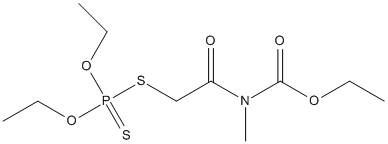Mecarbam
General
Type : Insecticide,Organophosphate,Carbamate,Sulfur Compound
Chemical_Nomenclature : ethyl N-(2-diethoxyphosphinothioylsulfanylacetyl)-N-methylcarbamate
Canonical SMILES : CCOC(=O)N(C)C(=O)CSP(=S)(OCC)OCC
InChI : InChI=1S\/C10H20NO5PS2\/c1-5-14-10(13)11(4)9(12)8-19-17(18,15-6-2)16-7-3\/h5-8H2,1-4H3
InChIKey : KLGMSAOQDHLCOS-UHFFFAOYSA-N
Other name(s) : Marfotoks,Criotox,Mecarbame,Mercarbam,Murfotox
MW : 329.36
Formula : C10H20NO5PS2
CAS_number : 2595-54-2
PubChem : 17434
UniChem : KLGMSAOQDHLCOS-UHFFFAOYSA-N
IUPHAR :
Wikipedia :

Target
References (5)
| Title : Experiences with acute organophosphate poisonings in Crete - Tsatsakis_1996_Vet.Hum.Toxicol_38_101 |
| Author(s) : Tsatsakis AM , Aguridakis P , Michalodimitrakis MN , Tsakalov AK , Alegakis AK , Koumantakis E , Troulakis G |
| Ref : Vet Hum Toxicol , 38 :101 , 1996 |
| Abstract : Tsatsakis_1996_Vet.Hum.Toxicol_38_101 |
| ESTHER : Tsatsakis_1996_Vet.Hum.Toxicol_38_101 |
| PubMedSearch : Tsatsakis_1996_Vet.Hum.Toxicol_38_101 |
| PubMedID: 8693683 |
| Title : Neuropathy following acute intoxication with Mecarbam (OP ester) - |
| Author(s) : Senanayake N |
| Ref : Acta Neurologica Scandinavica , 85 :77 , 1992 |
| PubMedID: 1546539 |
| Title : Neuropathy following acute intoxication with Mecarbam (OP ester) - Stamboulis_1991_Acta.Neurol.Scand_83_198 |
| Author(s) : Stamboulis E , Psimaras A , Vassilopoulos D , Davaki P , Manta P , Kapaki E |
| Ref : Acta Neurologica Scandinavica , 83 :198 , 1991 |
| Abstract : Stamboulis_1991_Acta.Neurol.Scand_83_198 |
| ESTHER : Stamboulis_1991_Acta.Neurol.Scand_83_198 |
| PubMedSearch : Stamboulis_1991_Acta.Neurol.Scand_83_198 |
| PubMedID: 1851595 |
| Title : Mother-fetus postmortem toxicologic analysis in a fatal overdose with mecarbam - Tsoukali-Papadopoulou_1987_Forensic.Sci.Int_35_249 |
| Author(s) : Tsoukali-Papadopoulou H , Njau S |
| Ref : Forensic Science International , 35 :249 , 1987 |
| Abstract : Tsoukali-Papadopoulou_1987_Forensic.Sci.Int_35_249 |
| ESTHER : Tsoukali-Papadopoulou_1987_Forensic.Sci.Int_35_249 |
| PubMedSearch : Tsoukali-Papadopoulou_1987_Forensic.Sci.Int_35_249 |
| PubMedID: 3428806 |
| Title : Comparison of the disappearance of eight organophosphorus insecticides from soil in laboratory and in outdoor experiments - Bro-Rasmussen_1970_Pest.Sci_1_179 |
| Author(s) : Bro-Rasmussen F , Noddegaard E , Voldum-Clausen K |
| Ref : Pest Sci , 1 :179 , 1970 |
| Abstract : Bro-Rasmussen_1970_Pest.Sci_1_179 |
| ESTHER : Bro-Rasmussen_1970_Pest.Sci_1_179 |
| PubMedSearch : Bro-Rasmussen_1970_Pest.Sci_1_179 |
| PubMedID: |